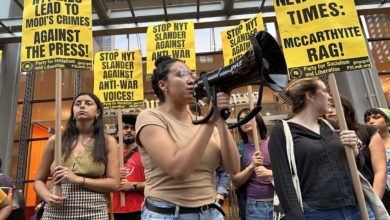The British film “Slumdog Millionaire” has been one of the year’s most talked-about movies. In addition to a highly lucrative run at the box office, the film earned several of the most prestigious awards in the film industry, including several Oscars. In recent months, however, discussions have centered not on the film itself, but instead on the exploitation of the film’s child actors.
|
Controversy over the exploitative and Orientalist nature of the film began well before the Academy Awards. Even before the film was released in India, residents of the Mumbai slums led protests, holding signs and banners that read, “I Am Not a Dog,” and “Poverty for Sale.” Community organizers took the cast and crew of the film to court over the bigoted title, noting that Indians were commonly referred to as “dogs” by British imperialists during colonialism.
Controversy has continued to unfold as the plight of two child actors in the film has become public knowledge. Azharuddin Mohammed Ismail and Rubina Ali, who played two of the main characters for the first 40 minutes of the two-hour film, are from the slums of Bandra, a suburb of Mumbai. Ismail was paid ?700 (approximately $1,160) for his work, while Ali received ?500 (approximately $830).
Director Danny Boyle vigorously denies any exploitation, citing that the two children were paid above local wages for 30 days of work on the film. Meanwhile, the film has grossed over $352 million in the box office.
Even after the film won eight Academy awards, both actors continued to live in deplorable conditions—Ali’s family in a one-room shack and Ismail’s family under a tarp by a busy road. Last month, Ismail and his family were forcibly evicted from their makeshift home by Mumbai police. The home was later demolished.
“Slumdog Millionaire” is an example of the many faces of imperialism. It is a film that has generated super-profits by not only sensationalizing the contradictions of capitalism in India, but also directly exploiting those who suffer from such contradictions. The film is a microcosmic example of how imperialism does not stop at political and economic conquest, but seeps deep into the cultural fabric of society by shaping the way that the world understands the experiences of oppressed peoples in other parts of the world.
India gained independence from the British Crown in 1947, but the working class and peasants of India, like their counterparts throughout Asia, Africa and Latin America, are still beholden to Western finance capital through a form of imperialism popularly called “neocolonialism.”
Under neocolonialism, native governments have formal sovereignty, but are in large measure subordinated to the interests of imperialist domination. As progressive political scientist Michael Parenti states, “Colonel Blimp is dead and buried, replaced by men in business suits. … [T]he flag stays home, while the dollar goes everywhere—frequently assisted by the sword.”
This is the case with India. Over half a century after independence, the poor and working-class people of that vast and populous country are still plagued by many of the same ills they suffered under British imperialism. With a population of 1.17 billion, India represents 17 percent of the world’s population. Nearly half of that population—more than the total population of the United States—lives under the global poverty line of $1.25 per day.
The government of India, at the insistence of Western finance capital, continues to privatize state-run companies, allow direct foreign investment in banks, increase corporate tax cuts, and dismantle social services and price supports. Workers in India have waged militant struggles against these “reforms,” including coordinating general strikes throughout the large nation.
While making millions of dollars for British and U.S. film companies through an exotic and sensational portrayal of poverty in Mumbai, “Slumdog Millionaire” conveniently overlooks centuries of colonization and the ongoing neocolonial plundering as a primary cause of poverty in India. The film encourages viewers with little or no knowledge of modern Indian history to believe that religious infighting and local mobs are the source of the problems in the slums of Mumbai.
“Slumdog Millionaire” has had enormous financial success as the “feel-good” movie of 2008. Yes, we feel good at the end of the film, because the protagonist’s suffering ends in an instant by answering a multiple choice question correctly on a television game show.
But this is not a reality for 99.99 percent of poor and working people of the world. As actors Ismail and Ali can tell you, not even landing the leading role in the most distinguished film of the year can transform a “slumdog” into a “millionaire.” Rather, it was international outrage at the exploitation of these two actors that finally compelled Boyle and the Indian government to compensate them in a fair manner.
For progressive and revolutionary people everywhere, our understanding of the experiences of oppressed people in other parts of the world must be shaped through class-conscious inquiry, not through the eyes of filmmakers whose ultimate concern is the bottom line at the box office.






